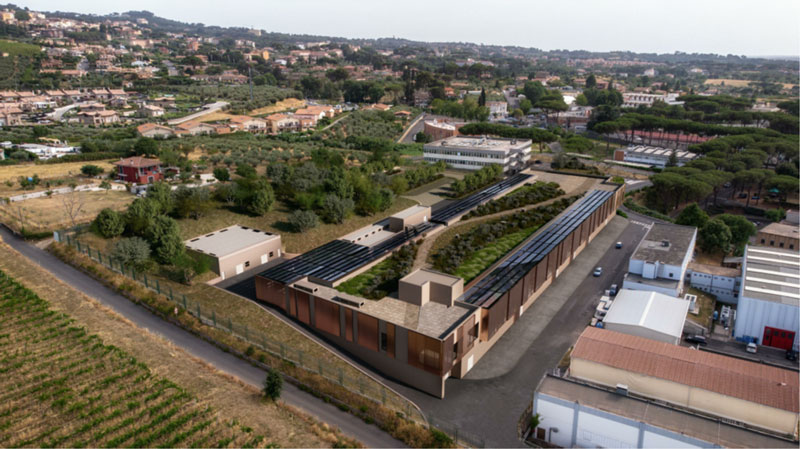
Projected building for the particle-driven plasma accelerator of EuPRAXIA in Frascati, near Rome. Credit: INFN & Mythos – consorzio stabile s.c.a.r.l.
Do you want to keep up to date? Subscribe to our newsletter. 1mail every 2months! |
 |
24th November 2022 - The European plasma accelerator community has received a major impulse for the development of a user-ready plasma accelerator facility with the funding of several multi-million euro initiatives under the umbrella of the EuPRAXIA project. These are EuPRAXIA Preparatory Phase, EuPRAXIA Doctoral Network, and EuPRAXIA Advanced Photon Sources, as well as funding for the construction of one of the sites of EuPRAXIA in Frascati, near Rome.
The EuPRAXIA project aims at the construction of an innovative electron accelerator using laser- and electron-beam-driven plasma wakefield acceleration that offers a significant reduction in size and possible savings in cost over current state-of-the-art radiofrequency-based accelerators.
The EuPRAXIA project started with a Design Study, which was funded under the EU Horizon 2020 programme, and culminated at the end of 2019 with the publication of the worldwide first Conceptual Design Report for a plasma accelerator facility. EuPRAXIA was then included in 2021 in the European Strategy Forum on Research Infrastructures (ESFRI) Roadmap, which identifies those research facilities of pan-European importance that correspond to the long-term needs of the European research communities.
Now the EU and the UK Research and Innovation Guarantee Funds have awarded 3 M€ to the EuPRAXIA Preparatory Phase (PP), which comprises 34 participating institutes from Italy, Czech Republic, France, Germany, Greece, Hungary, Israel, Portugal, Spain, Switzerland, United Kingdom, USA and CERN as International Organization.
The new grant will give the consortium a unique chance to prepare over the next four years the full implementation and realisation of EuPRAXIA. The project will fund 548 person-months, including additional funding from UK and Switzerland, and will be supported by an additional 1,010 person-months in-kind. EuPRAXIA-PP will connect research institutions and industry from the above countries plus China, Japan, Poland, and Sweden, which had signed the EuPRAXIA ESFRI consortium agreement.
ALBA participates in the project in two work packages, one dedicated to the design of accelerators components, such as RF structures, compact magnets and magnetic undulators; and the other dedicated to the design and development of particle and photon beam diagnostics. All of them tailored to plasma accelerators, and with the aim to prepare a TRL (Technology Readiness Level) report which should guide the research and development efforts required to be able to build in the future a FEL (Free Electron Laser) based in Plasma Accelerators.
This Preparatory Phase project will define the full implementation of the 569 M€ EuPRAXIA facility as a new, distributed ESFRI Research Infrastructure for Europe.
Alongside EuPRAXIA-PP, a new Marie Skłodowska-Curie Actions Doctoral Network (EuPRAXIA-DN), coordinated by INFN – Italian National Institute for Nuclear Physics, has also been funded by the EU and the UKRI Guarantee Funds. EuPRAXIA-DN will offer twelve high-level fellowships between universities, research centres and industry that will carry out an interdisciplinary and cross-sector plasma accelerator research and training program. The network will start in January 2023 and benefit from more than 3.2 M€ of funding over its four-year duration.
EuPRAXIA-DN will focus on scientific and technical innovations and on boosting the career prospects of its Fellows. The project comprises a lot of the European expertise in this research area and involves ten universities, six national and international research centres, as well as seven partners from industry at project start.
Finally, the Italian Ministry of Universities and Research is supporting through the Next Generation EU recovery funds (PNRR) the EuPRAXIA Advanced Photon Sources project (EuAPS) with 22 M€. The project has been promoted by INFN (leading institution), CNR – Italian National Research Council, and Tor Vergata University of Rome.
EuAPS will fulfil some of the scientific goals defined in the EuPRAXIA Conceptual Design Report by building and commissioning a distributed user facility providing users with advanced photon sources; these consist of a plasma based betatron source delivering partially coherent soft X-rays, a mid-power, high repetition rate laser, and a high power laser.
The above mentioned funding comes in addition to about 120 M€ funding for construction of the beam-driven pillar of EuPRAXIA at Frascati, close to Rome, provided by Italian government, the Latium region and INFN. Research and development activities for the beam-driven facility are currently being performed at the INFN SPARC_LAB laboratory in Frascati. The European site for the second, laser-driven leg of EuPRAXIA will be decided in June 2024 as part of the Preparatory Phase project.
The EuPRAXIA Conceptual Design Report has been published in the European Physics Journal: https://doi.org/10.1140/epjst/e2020-000127-8. The update of the ESFRI roadmap from December 2021 is available at https://www.esfri.eu/esfri-roadmap




